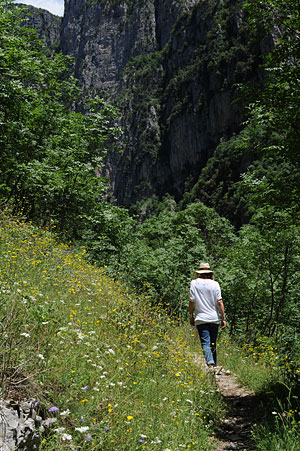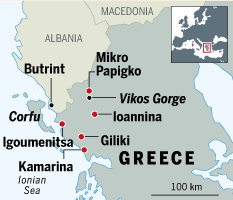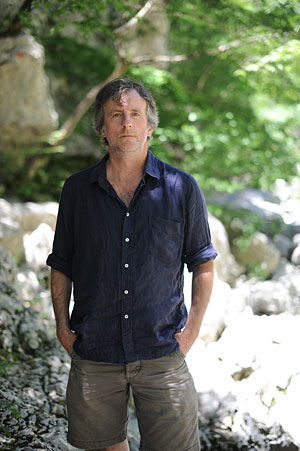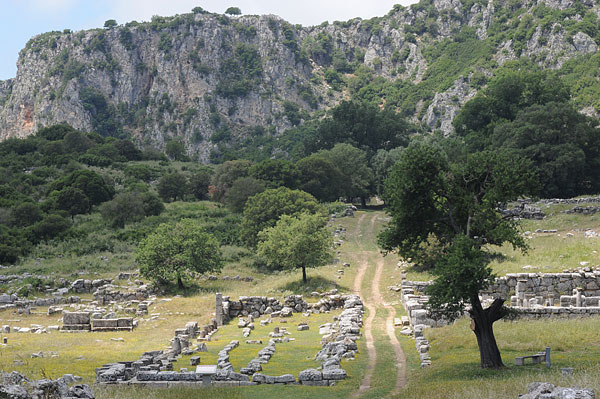Ancient paths

Simply sign up to the Life & Arts myFT Digest -- delivered directly to your inbox.
Ever since being dragged around the Peloponnese as a teenager, I’d given ruins the widest possible berth. So when a friend told me I needed to meet Rupert Smith, a British guide to classical sites, I didn’t have high expectations. But Smith, she said, was different. He had recently been hired for an eight-day tour of Greece in a superyacht, during which his role was to bring to life Homer’s Odyssey in theatrical re-enactments. These included searching for the Minotaur, an event Smith produced with a real bull and five actors in a deserted labyrinthine village. I was intrigued.
He turns out to be a handsome 52-year-old former jazz-club owner, mushroom farmer and Oxford-educated classicist. Today he runs the Evia School, a centre for the study of Greek language and culture, as well as leading trips and walks around the ancient Mediterranean world. Many of the walks follow routes linking ancient sites – from the Altar of Zeus at Pergamon to the temple of Apollo Epicurius at Bassae, for example, or over Mount Parnassus to Delphi.
All the trips are bespoke, and we decide on a five-night itinerary focusing on Epirus, a region that in ancient times straddled southern Albania and northwest Greece, with the town of Ioannina at its centre. The area is a warp and weft of Muslim, Christian, Greek, Roman and Ottoman strands of history. Smith says we’ll go to the gates of Hades – home of the Nekromanteion, where narcotics, priests and theatrical hydraulics enabled pilgrims to commune with the dead – and walk the Vikos Gorge, which is a full day’s hike. We’ll visit the Oracle of Zeus at Dodona, and the Pindus Mountains’ Ottoman stone arched bridges.
When I show up at Corfu airport, the hillsides are covered in white lace flowers peppered with spots of blood-red poppies and trumpeting euphorbia. A storm recedes as we pull away on the car ferry towards the Greek mainland port of Igoumenitsa. Looking back, we see sheets of purling rain drench the island’s interior, making Corfu appear even more emerald against the inky backdrop of the sky.

From Igoumenitsa, we drive across the border into Albania to reach Butrint, a Unesco-protected site, in the honeyed light of late afternoon. “Day trippers come in the morning from Corfu Town,” says Smith. He points out some bald, pinpricked dolls’ heads sitting atop gateposts, used to ward off the evil eye.
We eat in the village of Mursia, in a no-name restaurant Smith calls the Garage after the disused pump outside. There’s a television that doesn’t work, and a table of chain-smoking locals. We eat tas kebap (local lamb stew) and pilaf rice. To this is added lashings of sheep’s yoghurt, creating the most spectacular €4 meal of my life. But there’s another reason we’re here. Smith used to eat at the Garage every evening from 2006 to 2008 when he headed up the Butrint Foundation, an archaeological charity co-founded by Lords Sainsbury and Rothschild.
He therefore knows his way around Butrint better than most, from its 3rd-century BC sanctuary dedicated to Asclepius, the god of medicine, to the 6th-century AD baptistery. A mosaic here is kept covered for its protection; without Smith, I would have missed a spectacular description.

What I enjoy most of all, however, is the fact I have the hilltop site entirely to myself – the ruins covered in leaf-fall from the laurel forests, which shadow narrow paths and occasionally open up to reveal a still lagoon.
By the time we’re back in Greece, walking the Acheron, one of the five rivers of the Greek underworld, it is clear that Smith knows what he’s doing. From Gliki, a town on the edge of Souli country (Gliki, rather deliciously, translates as “sweet spot”), we proceed alongside riverine beaches bleached white in the sun. The gully narrows until it is thick with ferns, the scent of chamomile and wild thyme. Then rockfalls block our way. “Getting a bit goaty,” says Smith, switching routes one, two, three times. For ancient Greeks, he says, Acheron stood on the edge of their imagination. I now see why. This is a wild and compelling gorge – there are no other tourists (all week, we pass fewer than 10 walkers) – where Smith shows me springs bubbling into the river, which the ancients believed were icy waters rising up from Hades.
So the days roll on, from mapless hikes through Epirus’s spectacular mountains to classical sites where it’s as if I’m the first person in weeks to disturb grass prickling with crickets. Smith chooses a perfect mountain guest house, Dias, in the village of Mikro Papigko – made more memorable for its €35 per person per night price tag, including breakfast – with a restaurant serving earthy horta (wild spinach) and fasolakia (green beans) in front of an open fire. We visit Kassope, a 4th-century BC Hellenistic settlement on a high escarpment near the village of Kamarina. I ask an archaeologist working on the site if it’s always this empty. Maybe three tourists a day, she says; the most she ever sees is 10, even in high season. Smith says later that Kassope is possibly his favourite site in Greece.

For me, it’s the view that steals the show: the Ambracian Gulf to the left, the Ionian Sea on the right, with silver olive trees and threads of river reaching out across the plain below. Where the two coasts meet lies a channel, where the Battle of Actium took place in 31BC. Smith tells the story, how Mark Antony and Cleopatra became lovers, how Octavian and Mark Antony fought a great sea battle, how the victor changed his name to Augustus and brought stability to the Roman Empire that lasted for the next 400 years. Smith is popping stories into my head – the poetry of Virgil, the “imperial anarchs” described by Byron – then points out Ithaca in the far distance. “You’ve even got Odysseus in the background,” he says.
Towards the end of the trip, I ask Smith if the superyacht owner – who booked him again this year – gets the same treatment. “He gets the same person, yes. I have to do it my way,” he says. “There are moments when I don’t mind being a theatrical impresario. I just don’t want to be an accessory – to become someone else’s handbag.” Then he asks if I’m hungry. Before I’ve answered, we’re pulling over to buy bougatsa (a filo pastry piled with custard) from a roadside takeaway. I cannot help but smile. I suspect he planned this drive-by – the bougatsa is second to none – but in disguising the depth of forethought to his trips, I’m made to feel it’s all so serendipitous (for the labyrinthine village, I later discover Smith did a day’s scouting in a helicopter).
So completely does he immerse me in his world, in fact, I wonder for a moment if I too might chance upon the Minotaur.
——————————————-
Details
Sophy Roberts was a guest of Rupert Smith (www.theeviaschool.com). All his trips are bespoke but, as a guideline, a five-night trip such as the one described through Epirus, for a party of four, costs from about £1,000 per person, half-board, not including flights
——————————————-
More historic walks: One foot in the past
Via Ferrata, Italy
For much of the first world war, Italian and Austrian troops fought along a front line through the Dolomites, writes Tom Robbins. For easy access to the mountaintop forts, gun positions and tunnels, they hammered steps and safety cables into the rock, creating a network of “iron ways”. Visitors can still follow these routes, stopping at museums along the way. The Rosa Alpina hotel in San Cassiano can arrange guides for day trips; Mountain Tracks offers longer, more strenuous, itineraries.
www.rosalpina.it; www.mountaintracks.co.uk
Kumano Kodo, Japan
Inside Japan’s two-week Pilgrim’s Path trip includes five days hiking along the ancient Kumano Kodo, a network of paths between shrines and temples that is at least 1,000 years old. Walkers, who are self-guided, stay in temple lodgings and traditional ryokans, and can join pilgrims for morning meditation sessions.
Lycian Way, Turkey
This 300-mile route takes walkers along spectacular coastline, via ancient Lycian sarcophagi, ruined Greek temples and Crusader castles. Inntravel offers a nine-day self-guided trip, covering around 50 miles, with luggage transferred between hotels.
Offa’s Dyke, Wales
Built by King Offa in the eighth century, Offa’s Dyke formed the frontier between England and Wales. Today a path runs along the earthwork for 176 miles, passing historic sites and market towns. Welsh tour operator Drover Holidays offers both group and self-guided trips.
Comments